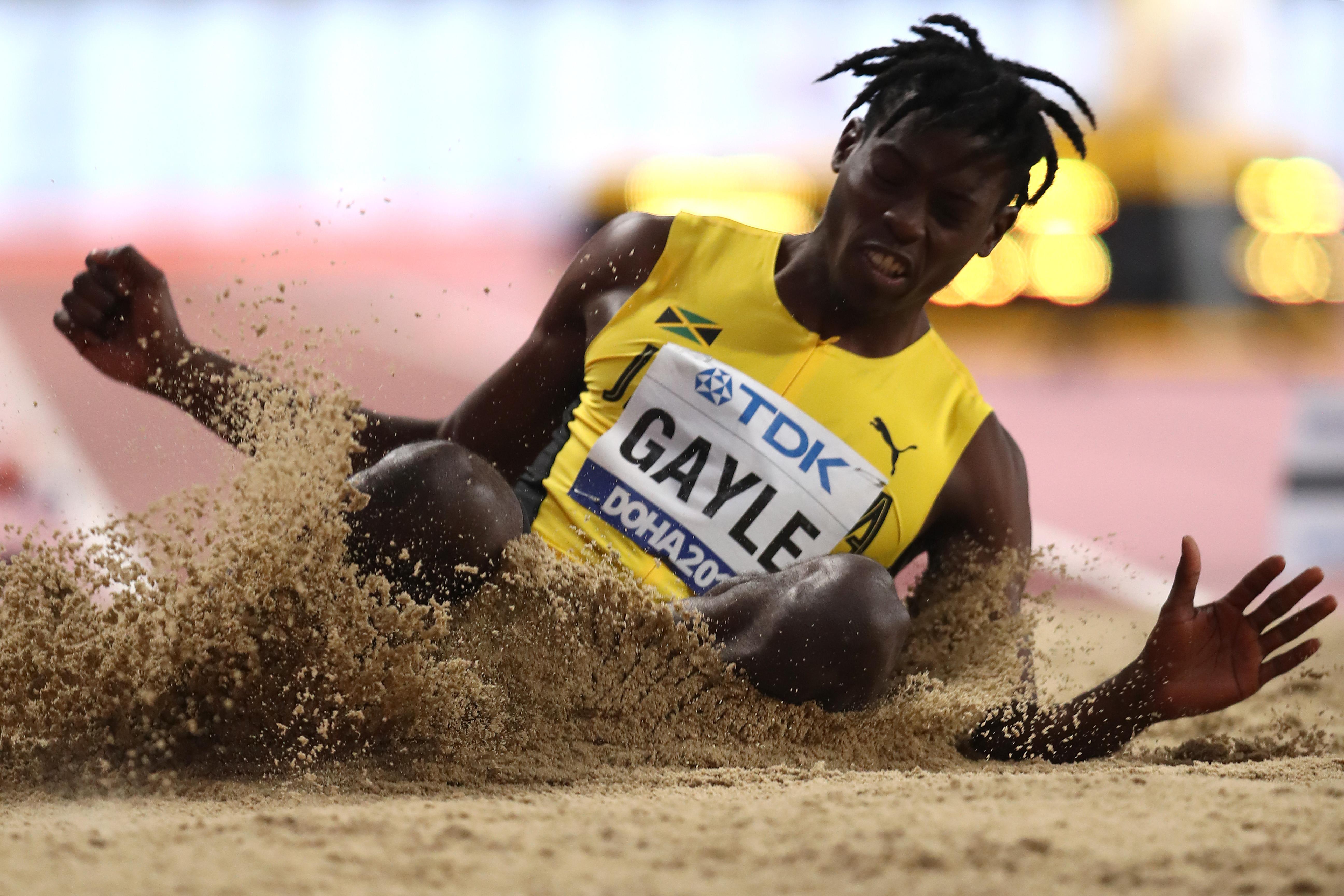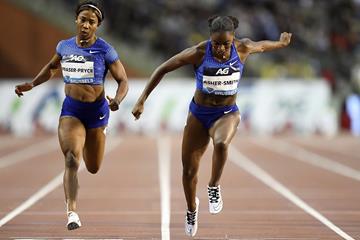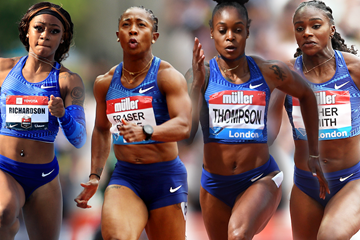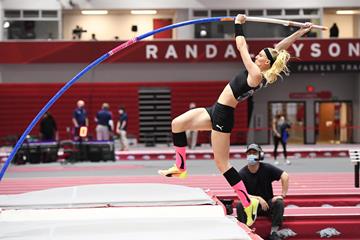 Countdown
Countdown
 Countdown
Countdown
The long jump is a track and field event that requires competitors to sprint along a runway until they reach a take-off board. From here, they jump as far as possible into a sandpit. The distance travelled, from the edge of the board to the closest indentation in the sand, is then measured and the winner is the athlete who jumps the farthest.
The history of the long jump can be traced back to the Ancient Olympic Games in Greece, when athletes carried weights in each hand. These were swung forward on take-off and released in the middle of the jump in a bid to increase momentum
The men’s long jump has been part of the Olympics since the first Games in 1896
The women’s long jump has been part of the Olympics since 1948
The long jump requires athletes to have strength, speed, flexibility and agility
To be successful, long jump athletes must display an incredible blend of speed, explosive power, strength and agility.
The first women’s long jump world record was set by Czechoslovakia’s Marie Mejzlikova, who jumped 5.16m (16ft 11in) in 1922. A year later, Mejzlikova went on to break her own record with a jump of 5.30m (17ft 4 1⁄2in).
The current women’s long jump record has stood for more than 30 years. In 1988, Galina Chistyakova jumped 7.52m (24ft 8in) in Leningrad. This shows how much athletes have improved over the years, with Chistyakova’s record being more than 2 metres farther than Mejzlikova’s. The athlete to have got closest to the record over the past almost 40 years is Jackie Joyner-Kersee, who jumped 7.49m twice in 1994.
The very first men’s long jump world record was set way back in August 1901, when Irish athlete Peter O’Connor jumped 7.61m (24ft 11 ½in). Ever since, the men’s long jump world record has been dominated by US athletes. Back in 1935, Jesse Owens jumped an incredible 8.13m (26ft 8in), a world record that stood for 25 years.
At the Olympic Games in 1968, Bob Beamon made the most of the altitude in Mexico City, flying out to a world record 8.90m (29ft 2 1⁄4in). Today, the men’s long jump world record is held by Mike Powell, who jumped 8.95m (29ft 4 1⁄4in) at the 1991 World Championships.
Since 1896, the men’s Olympic long jump has been dominated by US athletes. They have won gold at every Games except seven.
As he won four successive Olympic titles (1984-1996), Carl Lewis is widely regarded as the greatest long jumper of all time. To date, he’s one of only six Olympic athletes to have won a gold medal in the same individual event in four consecutive Games.
Other notable men’s long jump athletes include Olympic and World Championships gold medallist Greg Rutherford, four-time world champion Dwight Phillips and Greece’s Miltiadis Tentoglou, who has won one Olympic gold medal and two world titles.
Unlike the men’s competition, the women’s long jump has not been dominated by one country. In fact, the inaugural women’s Olympic long jump took place in 1948 and athletes from five different regions have struck gold; Europe, North America, South America, Africa and Oceania.
Notable women’s long jump athletes include four-time world champion Brittney Reese, Olympic and two-time world gold medallist Malaika Mihambo and Jackie Joyner-Kersee, who won one Olympic gold and two world golds in the long jump alongside her heptathlon titles.

The basic long jump technique can be broken down into five phases:
During the approach run, long jumpers must gradually accelerate to a maximum controlled speed over a distance of around 20-22 steps. While competing, many athletes wear dedicated long jump spikes, which provide additional heel support and grip. Crucially, each athlete will only reach their maximum speed in the final few steps of the approach. Using energy in this way is vital, as each participant will jump multiple times in every competition.
In the last two strides of the approach run, the long jumper must prepare their body for take-off while still maintaining speed. During this time, they’ll lower their centre of gravity and prepare for what’s known as a ‘vertical impulse’. To achieve a maximum jumping distance, athletes generally try to leave the ground at an angle of 20 degrees or less.
The jumper will place their foot flat on the take-off board while keeping their torso upright and moving their hips forwards (jumping from the heel or the toe is not as effective). The exact style of take-off varies from athlete to athlete. While some will execute a kick-style take-off, others will use a double arm or a sprint motion instead.
While in the air above the long jump pit, athletes will focus on the hang, the sail and the hitch-kick. These techniques combat the forward rotation experienced from the long jump take-off.
Although there’s little an athlete can do to extend the jump significantly once they’re airborne, they need to ensure they land properly, as this will affect the distance measured. For example, if an athlete falls backwards when they hit the long jump sand, the distance measured will be reduced.
Several long jump rules are used to standardise the event and ensure it is fair for all competitors, including:
At the elite level, competitors run down a runway that’s 40 metres in length. This is usually coated with the same rubberised surface as a running track. They then jump as far as they can from a wooden or synthetic long jump take-off board that is 20cm wide and is fitted flush with the runway.
Long jump rules state that a foul is committed – and the jump is not measured – if an athlete steps beyond the board and crosses the take-off (foul) line. To detect this, a high resolution camera is placed along the take-off line. If camera detects the breach, a foul has occurred.
At some local meetings, instead of a camera, a layer of plasticine is placed at a 90° angle immediately after the board. An official is charged with watching the jump and determining whether a foul has been committed.
Competitors may initiate their jump from any point behind the take-off line. However, the distance of the jump will always be measured from the take-off line to the nearest break in the sand. As a result, competitors will strive to get as close to the take-off line as possible, without breaking it.
In multi-day competitions like the Olympics or the World Championships, qualification phases are held before the main competition to select finalists. In these qualification rounds, participants are usually given three attempts to reach a qualification distance.
In a Final, the competitors out of the best 8 after 3 jumps are usually eliminated . The remaining competitors (usually eight ) then complete their final three jumps.
During competitions, all valid attempts (that are not fouls) are recorded, but only the best jump of each competitor counts towards the final result. This means that the competitor with the longest valid jump out of their six attempts is declared the winner. If two competitors tie, their next-longest legal jump is used as a tie-breaker.
The wind speed must be below 2.0m/s (4.5 miles per hour) for the jump to be considered wind legal.
Yes, there’s nothing preventing you from using sprint spikes for the long jump and they will help you gain traction during the approach. However, they’re not the best type of spikes for take-off and landing due to the limited support and cushioning at the heel. This makes the risk of discomfort and injury a little higher and is likely to impact your performance.
The number of strides an elite long jump athlete will take during the approach is around 18 to 22. Intermediate athletes will take around 14 to 18, while beginners will take around 10 to 14.
Most championship competitions involve six jumps per competitor, although those with the shorter marks are often eliminated after three jumps. At major championships the format is usually a qualification session followed by a final.
 ITA
ITA
 SUI
SUI
 AUS
AUS
 GRE
GRE
 JAM
JAM
 JAM
JAM
 BUL
BUL
 CHN
CHN
 SWE
SWE
 CHN
CHN
 USA
USA
 GER
GER
 ITA
ITA
 FRA
FRA
 USA
USA
 COL
COL
 USA
USA
 SUI
SUI
 POR
POR
 USA
USA







